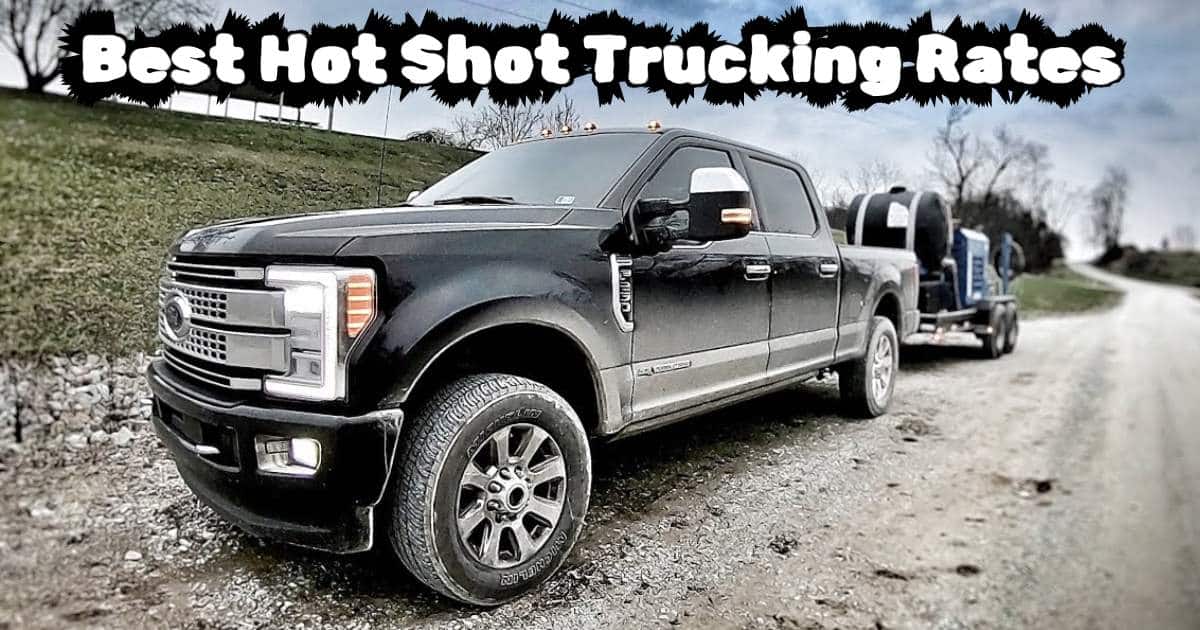As a hot shot driver, one of the most critical decisions you’ll make is setting your rates per mile.
Get it right, and you’ll cover your costs while earning a healthy profit. Get it wrong, and you could end up losing money on every load you haul.
Determining the ideal hot shot trucking rates is both an art and a science. You need to factor in all your expenses, understand the market demand, and price yourself competitively.
Sounds complicated? Don’t worry – this guide will walk you through a simple 5-step process to calculate your perfect per-mile rate.
But before we dive in, let’s look at how to estimate the overall cost of hot shot trucking rates per mile.
How To Estimate The Cost Of Hot Shot Trucking Rates Per Mile?
Generally speaking, hot shot rates fall somewhere between $1.50 to $4 per mile. But that’s a vast range that doesn’t account for your unique situation as a hot shot driver. Several key factors influence what you should charge:
- Distance: Hot shot rates may be higher for longer hauls since the driver will need to spend more time and resources on the road.
- Weight and Dimensions: Larger or heavier shipments may require specialized equipment or handling, increasing costs.
- Urgency: Hot shot rates are typically higher for urgent, time-sensitive deliveries where the driver needs to prioritize and accommodate specific timelines.
- Special Requirements: If a customer has unique needs like a specific trailer type or specialized handling, it can drive up costs.
To get an accurate quote, you’ll need to calculate your all-in cost per mile based on expenses like fuel, permits, insurance, and your desired profit margin. Here’s how:
5 Steps To Calculate Your Rates Per Mile For Hot Shot Trucking
Follow this simple 5-step process, and you’ll have your custom hot shot rates dialed in perfectly:
Step 1: Estimate Fuel Costs
Fuel is one of your biggest expenses as a hot shot driver, so this is a great place to start. To calculate fuel costs:
- Determine the total distance of the load’s route using a tool like Google Maps.
- Research your truck’s fuel efficiency (MPG) based on its year, make, and model.
- Find the current cost of diesel or gasoline in that region.
- Use this formula: Total Distance / Truck MPG * Cost per Gallon = Total Fuel Cost
For example, let’s say you’re hauling a load 500 miles, your truck gets 20 MPG, and diesel is $4 per gallon:
500 miles / 20 MPG * $4/gallon = $100 in fuel costs
Step 2: Calculate All Road Permit and Miscellaneous Costs
There are a number of smaller fees and expenses that can really add up over the course of a hot shot hauling job. Be sure to account for things like:
- Toll road fees
- Parking/Unloading fees
- Permit costs
- Insurance
- Maintenance and repairs
Go through your route and make note of any toll roads. Research permit requirements and costs for the roads and bridges you’ll travel. Factor in your typical maintenance schedule based on the miles driven.
Don’t make the mistake of underestimating these miscellaneous costs – that’s a surefire way to eat into your profits.
Step 3: Factor in Empty Miles
As a hot shot driver, you’ll inevitably have to drive some “empty miles” or “deadhead miles” where your truck is empty after dropping off a load. You need to account for the costs of these miles.
Industry experts estimate that around 30-40% of total miles driven are empty miles for hot shot loads. That’s a massive operating cost you can’t ignore.
Let’s look at an example:
- Your loaded hot shot hauling route is 1,000 miles roundtrip
- After delivering, you have to drive 400 empty miles to pick up your next load
- Even though you only hauled a paid load for 1,000 miles, your total mileage was 1,400 miles
- If you only charged for the 1,000 loaded miles, you’d be underestimating your costs by over 25%!
When calculating your per-mile pricing, be sure to include your expected percentage of empty miles driven. It’s an oft-overlooked expense that can make or break your profitability.
Step 4: Add Desired Profit Percentage
Up to this point, you’ve tallied up all your operating expenses for a given hot shot load. Now it’s time to build in a healthy profit margin – you are running a business, after all!
Most hot shot drivers aim for a profit margin between 5-10% on top of their hard costs. So take the sum of your fuel, permit, misc., and empty mile costs and tack on your desired profit percentage.
For example, if your total calculated costs for a 500-mile hot shot load came to $600, you could add a 10% profit margin for a total charge of $660.
Don’t be afraid to adjust this percentage based on market conditions, either. If hot shot demand is high in your area, you may be able to command a higher profit. If it’s slow, lower your margin temporarily to stay competitive.
Step 5: Divide Total Costs By Miles Traveled
In this final step, you’ll divide your total calculated costs (including profit) by the entire trip mileage to get your ideal hot shot rate per mile.
Sticking with our previous example:
- Total calculated costs (including 10% profit): $660
- Total miles driven (including 40% empty miles): 700 miles
- Rate per mile: $660 / 700 miles = $0.94 per mile
So for that 500-mile paid hot shot hauling load, the ideal rate you should charge is $0.94 per mile to cover your costs and earn a 10% profit margin.
7 Must-Ask Queries Before Setting Hot Shot Rates
Even after running the numbers, there are still some key questions to ask yourself before locking in hot shot rates:
What is the weight and size of the shipment?
If the shipment is oversized, heavy, or requires special equipment, it will increase your operating costs. Be sure to adjust your pricing accordingly for larger hot shot hauling jobs.
How far will the shipment travel?
The further the distance, the more expenses like fuel, maintenance, and driver costs will come into play. Longer hot shot trucking routes demand higher rates.
Is the shipment time-sensitive or require expediting?
Urgent deliveries that require faster travel or accommodation of specific time windows should command a premium rate for the hot shot driver’s prioritization.
Are any additional services required?
Extra services like specialized handling, loading/unloading assistance, or additional driver staffing can add costs. Don’t be afraid to charge more for ad-hoc services.
What are the current market rates?
Research what other hot shot trucking companies and independent drivers are charging for similar loads in your area. Your rates should be competitive.
What are your overhead costs?
From insurance to truck payments to home office expenses, don’t forget to factor your overhead into your pricing model.
What is the demand level for hot shot services?
If demand is high, you may be able to charge a premium. If it’s low, lower your rates temporarily to stay competitive and keep trucks moving.
Why Are Hot Shot Trucking Rates So Low in 2023?
You may have noticed hot shot rates are particularly low across the industry in 2023. Two major factors are driving this trend:
Pandemic Impacts
The COVID-19 pandemic fueled a surge in demand for trucking services, leading major carriers to rapidly hire thousands of new drivers. Now that consumer behaviors have shifted back to pre-pandemic norms, there is an oversupply of truckers competing for loads.
Ukraine Conflict
Russia’s invasion of Ukraine has caused diesel fuel costs to skyrocket over the past year. With fuel being such a large expense for hot shot hauling, these higher prices have put downward pressure on rates.
The combination of too many trucks fighting for limited loads and inflated fuel costs has created a precipitous drop in hot shot trucking rates in 2023. Hopefully, this is just a temporary imbalance that will self-correct as the economy stabilizes.
What is the Hot Shot Rate for Empty Miles Per Hour?
We’ve already covered how dead-head or empty miles are a significant operating expense for hot shot drivers hauling loads. But what if you’re driving empty miles between loads – how should you account for that time?
On average, hot shot trucks travel 30-40% of their total miles completely empty or without a paid load on board.
While the cost of fuel and maintenance for those miles needs to be factored into your per-mile rate, most companies do not actually compensate drivers for that empty travel time.
Why? Because the carrier is not generating any revenue when the trailer is empty. Paying the driver for those unpaid miles would result in a direct financial loss for the company.
Here’s an example:
- You pick up a load in Dallas and deliver it 1,000 paid miles away in Denver
- After the delivery, you have to drive 500 more miles empty to pick up your next load
- If your loaded rate was $2.50/mile, you’d earn $2,500 for the Dallas to Denver haul
- But if you also got paid that $2.50/mile rate for the 500 empty miles, that’s another $1,250 the company has to pay out with zero income
As you can see, compensating for those 500 empty miles at the same rate would result in a $1,250 loss for the carrier just for you to get to the next pickup. That’s not a sustainable business model.
So while scheduling loads efficiently to minimize empty miles is ideal, you can’t expect to get paid the same hot shot hauling rate for those non-revenue generating miles.
Factor the cost of empty miles into your per-mile pricing, but don’t count on recouping that time directly.
How to Evaluate a Hot Shot Rate Sheet
When vetting different hot shot trucking companies, pay close attention to how they structure their rate sheets. Here are some key things to look for:
Customized Service
Every customer’s shipping needs are unique, so a one-size-fits-all rate sheet isn’t going to cut it. Top hot shot operators should work closely with you to understand your requirements and build custom pricing accordingly.
Competitive Pricing
Hot shot hauling is a competitive business, so make sure the company’s rates align with current market pricing. You don’t want to overpay, but cheapest isn’t always best either.
Flexible Billing Models
Does the company offer multiple billing options like per-mile, per-hour, per-day or banded milage rates? Having flexibility in how you’re charged can help maximize efficiency.
Transparent Fees
Watch out for lots of hidden fees or surcharges tacked onto the base rate. All costs should be clearly spelled out from the start.
Fits Your Budget
At the end of the day, make sure the hot shot rates work within your budget and modelo while still allowing a reasonable profit margin. Unsustainably low pricing benefits no one.
Don’t just accept the first rate sheet you see. Shop around, ask questions, and find a hot shot trucking partner that offers transparent, fair, customized pricing for your needs.
How Does Hot Shot Trucking Work?
For those new to the hot shot world, here’s a quick overview of how these expedited trucking services work:
Hot shot trucking refers to the rapid delivery of smaller, time-sensitive loads using specialized trucks and drivers. Unlike traditional long-haul freight, hot shot loads are all about speed and reliability.
These loads typically involve hauling just a few pallets or pieces of equipment ranging from 5,000-45,000 lbs. Hot shot drivers use powerful diesel pickup trucks or small box trucks to rapidly transport these urgent shipments.
Some common examples of hot shot trucking loads include:
- Manufacturing equipment or machinery
- Rental equipment like generators or construction tools
- Automotive components for a plant shutdown
- Emergency repair parts for oil/gas operations
- Perishable or high-value freight
With their smaller truck sizes and incredibly fast transit times, hot shot truckers can provide same-day or next-day delivery for critical shipments across a regional area. This premium service comes at a higher cost, which is where calculating your ideal rates per mile comes into play.
Hot shot is an attractive niche for independent owner-operators and small fleets due to the higher revenues and unique lifestyle. If you have an eye for logistics and don’t mind hitting the road solo, it could be your ticket to profitability.

With a wealth of expertise spanning 6 years, I am a seasoned author in the realm of courier services information. My insights illuminate the intricacies of logistics and delivery solutions.






![Julia Boin JAV Bio, Net Worth, Career & Relation [2024 Complete Guide]](https://courierplate.com/wp-content/uploads/2024/11/Julia-Boin-JAV-Bio-Net-Worth-Career-Relation-2024-Complete-Guide-300x157.jpg)




